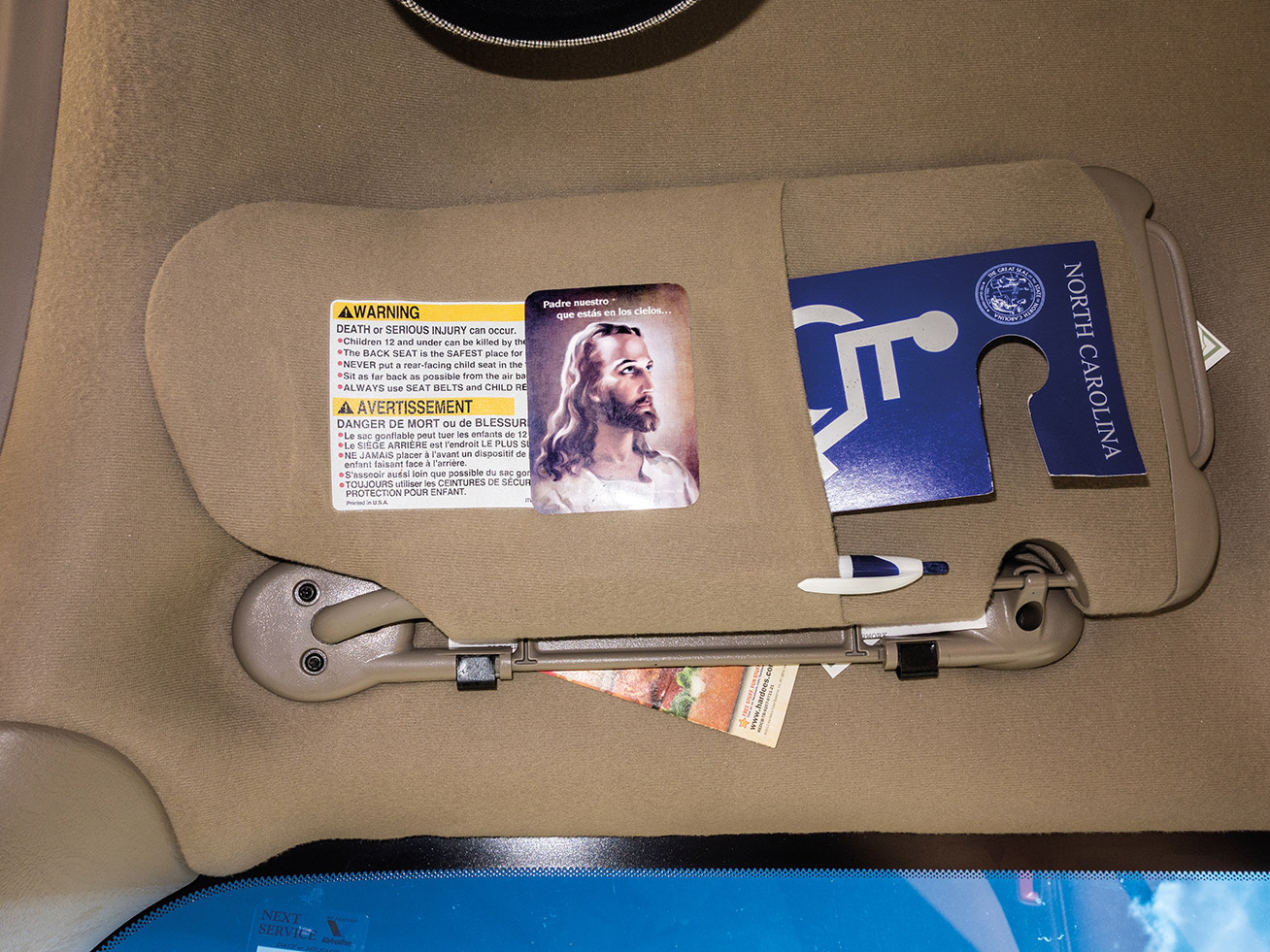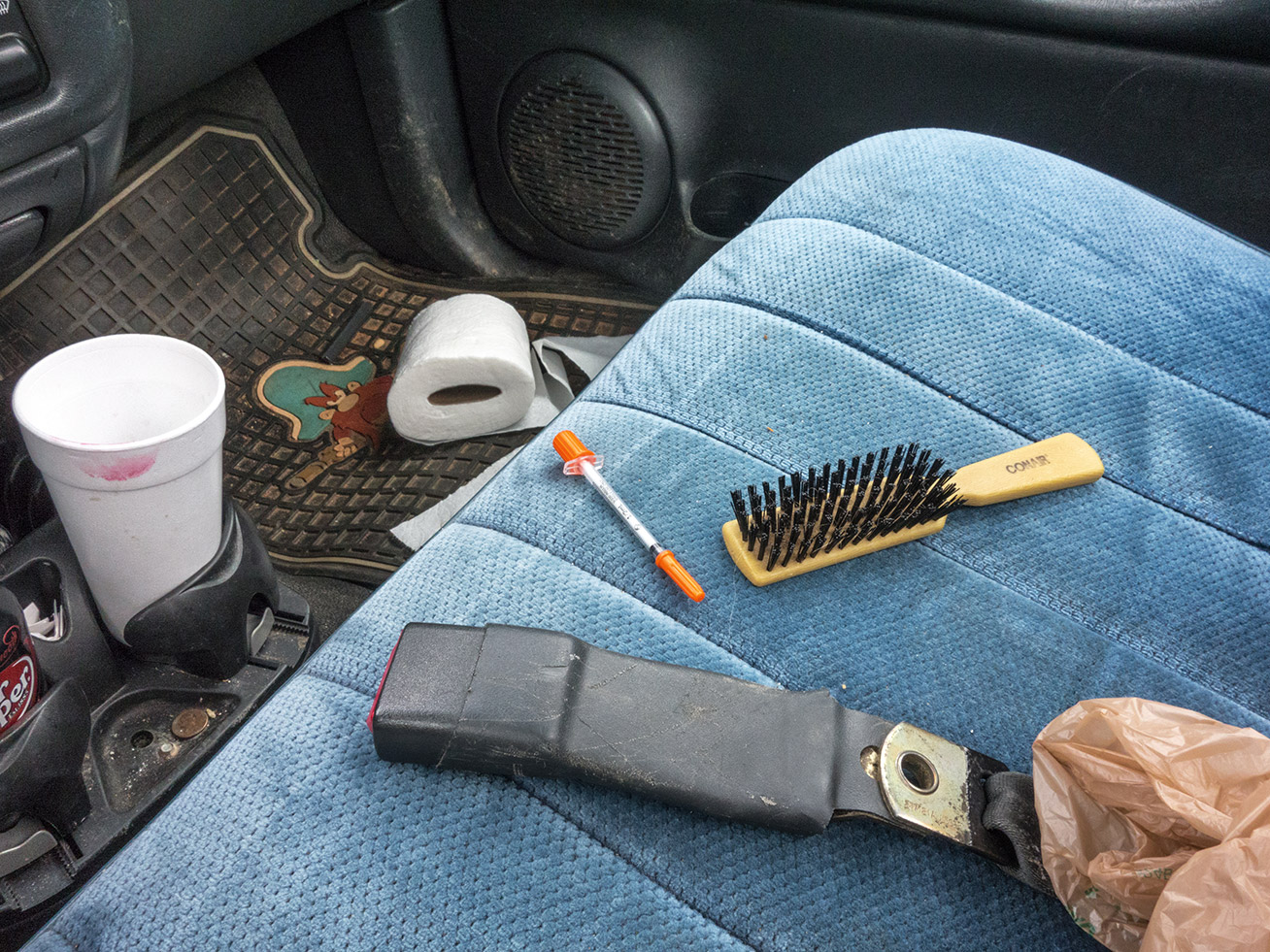The interiors of American veterans’ cars reveal the enduring toll of modern warfare

Drive out of Fort Hood, the sprawling military base in Texas, and you’ll spot a road sign: ‘You survived the war, now survive the roads.’
It’s one of the great ironies of modern warfare – soldiers are often in as much mortal danger at home as they are in a warzone. ‘And, for veterans home from war, the vehicle is a very dangerous place,’ says the American photographer ML Casteel.
Casteel was at a ‘strange intersection’ of his life. He had returned from a spell living in Alaska to move back in with his parents in Asheville, North Carolina. ‘I needed a job, and was willing to take anything,’ he says. He accepted the first opportunity that came along – as a parking valet for a local military veterans hospital.

Courtesy of Dewi Lewis Publishing
The job taught him a stark lesson. ‘For veterans, war brushes up into everyday life,’ he says. ‘It nestles amongst other problems. It creeps into the most mundane experiences. And, for some reason, those issues manifest themselves very starkly in a veteran’s car.’
For the next seven years, he would greet thousands of veterans, take their keys and park their car. With a small camera kept hidden in his pocket, and without letting his colleagues see, he would then quickly photograph the interior of the veteran’s car. He took more than 2,000 such pictures, holding the camera beneath the dash so as to avoid detection. ‘It felt like looking into someone’s chest of drawers,’ he says.
After a seven year gestation, Casteel’s clandestine work has resulted in the photobook American Interiors, published by Dewi Lewis Publishing. Casteel photographs have an honesty and intensity that dig deeper than a conventional portrait. They’re small, incomplete studies of trauma and addiction – at once hyper-masculine and deeply vulnerable. ‘They’re pictures of enduring internal wounds,’ he says.

Courtesy of Dewi Lewis Publishing
He opens the book with some startling statistics. College-educated veterans, on average, earn $10,000 less than civilians. Around one in seven homeless adults have served their country. Every day, 22 veterans take their own lives in America – that’s almost one suicide every hour.
Yet the nature of post-traumatic stress disorder (PTSD) is often misunderstood. Studies have shown chronic trauma is primarily determined not by what happened in the war, but by how alienated soldiers feel once they return home. As such, the vast majority of veteran suicides are amongst ageing soldiers whom served in more historical wars. Many of the vehicles shown in Casteel’s book belong to veterans of earlier wars – the first Gulf war, Vietnam, Korea, even the Second World War.
The images contain many of the things we might expect – and hope – to find; photos of family, children’s toys, letters from loved ones. There’s often religious iconography or the American flag. Yet they often lie alongside more troubling signifiers – crates of beer, bottles of spirits, cans of dog food overflowing with ash and cigarette butts, pornography, guns and knives, pills and syringes.

Courtesy of Dewi Lewis Publishing
Many of the veterans Casteel met struggle with addiction, or had compulsive relationships with weapons and firearms. ‘I would park a car for a particular veteran who kept a holster for his gun directly beneath his steering wheel, so he had access to it all the time,’ he says.
Another veteran had a gambling issue. ‘The passenger side of his car was piled high, from the footwell upwards, with scratch tickets. The steering wheel was covered in dust from the scratched-off tickets. I would wash my hands after parking his car.’ Many were alcoholics, or abused substances: ‘One day, a veteran who had been dry for a long time went to the supermarket and drank three bottles of Listerine.’
‘But I couldn’t help but respect them,’ he says. ‘They entered military service voluntarily, they did the bidding of the people that make the wars, and here they are, often decades later, still living with the consequences.’

From the series American Interiors, by ML Casteel.

From the series American Interiors, by ML Casteel.

From the series American Interiors, by ML Casteel.

From the series American Interiors, by ML Casteel.

From the series American Interiors, by ML Casteel.

From the series American Interiors, by ML Casteel.

From the series American Interiors, by ML Casteel.

From the series American Interiors, by ML Casteel.

From the series American Interiors, by ML Casteel.

From the series American Interiors, by ML Casteel.

From the series American Interiors, by ML Casteel.
INFORMATION
American Interiors, £28, published by Dewi Lewis Publishing. For more information, visit ML Casteel’s website
Receive our daily digest of inspiration, escapism and design stories from around the world direct to your inbox.
Tom Seymour is an award-winning journalist, lecturer, strategist and curator. Before pursuing his freelance career, he was Senior Editor for CHANEL Arts & Culture. He has also worked at The Art Newspaper, University of the Arts London and the British Journal of Photography and i-D. He has published in print for The Guardian, The Observer, The New York Times, The Financial Times and Telegraph among others. He won Writer of the Year in 2020 and Specialist Writer of the Year in 2019 and 2021 at the PPA Awards for his work with The Royal Photographic Society. In 2017, Tom worked with Sian Davey to co-create Together, an amalgam of photography and writing which exhibited at London’s National Portrait Gallery.
-
 The most comprehensive showing of Nan Goldin’s photographs and films is intense and emotional
The most comprehensive showing of Nan Goldin’s photographs and films is intense and emotionalNan Goldin's moving-image work makes a heavy impact in ‘This Will Not End Well’ at Milan’s Pirelli HangarBicocca
-
 How We Host: Interior designer Heide Hendricks shows us how to throw the ultimate farmhouse fête
How We Host: Interior designer Heide Hendricks shows us how to throw the ultimate farmhouse fêteThe designer, one half of the American design firm Hendricks Churchill, delves into the art of entertaining – from pasta to playlists
-
 Arbour House is a north London home that lies low but punches high
Arbour House is a north London home that lies low but punches highArbour House by Andrei Saltykov is a low-lying Crouch End home with a striking roof structure that sets it apart
-
 Inside the seductive and mischievous relationship between Paul Thek and Peter Hujar
Inside the seductive and mischievous relationship between Paul Thek and Peter HujarUntil now, little has been known about the deep friendship between artist Thek and photographer Hujar, something set to change with the release of their previously unpublished letters and photographs
-
 Nadia Lee Cohen distils a distant American memory into an unflinching new photo book
Nadia Lee Cohen distils a distant American memory into an unflinching new photo book‘Holy Ohio’ documents the British photographer and filmmaker’s personal journey as she reconnects with distant family and her earliest American memories
-
 Out of office: The Wallpaper* editors’ picks of the week
Out of office: The Wallpaper* editors’ picks of the weekThe rain is falling, the nights are closing in, and it’s still a bit too early to get excited for Christmas, but this week, the Wallpaper* team brought warmth to the gloom with cosy interiors, good books, and a Hebridean dram
-
 Inside Davé, Polaroids from a little-known Paris hotspot where the A-list played
Inside Davé, Polaroids from a little-known Paris hotspot where the A-list playedChinese restaurant Davé drew in A-list celebrities for three decades. What happened behind closed doors? A new book of Polaroids looks back
-
 Ed Ruscha’s foray into chocolate is sweet, smart and very American
Ed Ruscha’s foray into chocolate is sweet, smart and very AmericanArt and chocolate combine deliciously in ‘Made in California’, a project from the artist with andSons Chocolatiers
-
 Inside the process of creating the one-of-a-kind book edition gifted to the Booker Prize shortlisted authors
Inside the process of creating the one-of-a-kind book edition gifted to the Booker Prize shortlisted authorsFor over 30 years each work on the Booker Prize shortlist are assigned an artisan bookbinder to produce a one-off edition for the author. We meet one of the artists behind this year’s creations
-
 Out of office: The Wallpaper* editors’ picks of the week
Out of office: The Wallpaper* editors’ picks of the weekThis week, the Wallpaper* editors curated a diverse mix of experiences, from meeting diamond entrepreneurs and exploring perfume exhibitions to indulging in the the spectacle of a Middle Eastern Christmas
-
 14 of the best new books for music buffs
14 of the best new books for music buffsFrom music-making tech to NME cover stars, portable turntables and the story behind industry legends – new books about the culture and craft of recorded sound